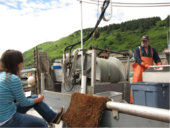Highlight
Whale Depredation on Alaska's Longline Fisheries
Achievement/Results
Depredation, or the removal or damage of fish and fishing gear by whales while fisherman are hauling in their catches, impacts fisheries worldwide. In Alaska, depredation primarily affects the economically significant halibut (Hippoglossus stenolepis) and sablefish (Anoplopoma fimbria) fisheries. IGERT trainee Megan Peterson is researching killer whale (Orcinus orca) and sperm whale (Physeter macrocephalus) depredation of longline fisheries in Alaska to identify possible mitigation strategies.
Depredation can have negative consequences to whales, fishermen, and the management of the fishery. Whales engaging in depredation have a higher risk of injury due to vessel strikes or entanglement with fishing gear. They can also become habituated to the presence of these food sources, altering their foraging behaviors and increasing their dependence on longline fisheries. Fishermen can be severely impacted by the reduction in a season’s catch due to depredation and the near complete loss of individual hauls in the presence of whales. The measures they take to avoid or mitigate for depredation, like increasing set times or moving to different fishing areas, can further increase the costs of operation. Depredation also affects efforts to sustainably manage these high valued fisheries. Without fully quantifying the losses due to depredation or incorporating this factor into measures of catch per unit effort (CPUE, a commonly used measure in fisheries management), the ability of fishery managers to accurate access the stocks is diminished.
Peterson is particularly interested in the geographic distribution of depredation, how depredation affects fishermen’s behaviors and attitudes, and what deterrent methods are most successful at reducing this negative interaction between fishermen and whales. While sperm whale depredation occurs primarily in the central and eastern Gulf of Alaska and in southeast Alaska, killer whale depredation is more likely to take place in the western Gulf of Alaska, the Aleutian Islands, and the Bering Sea. Working with collaborators at the University of Alaska Fairbanks, the North Gulf Oceanic Society, and the Auke Bay Laboratories and National Marine Mammal Laboratory (both part of the Alaska Fisheries Science Center, National Marine Fisheries Service, NOAA), Peterson analyzed a long-term longline survey data set collected by NMFS and found that, when depredating, killer whales removed or damaged an estimated 54-72% of sablefish catches across all regions and 51% of Pacific halibut catches in the western Gulf of Alaska. Furthermore, the researchers found that the frequency of depredation has increased in recent years in both the western Gulf and the Aleutian Islands.
These results are consistent with the feedback Peterson received from Alaskan fishermen in both interviews and written surveys. 87% agreed that whale depredation increased between 1990 and 2010. The surveys, which targeted experienced fishermen that averaged 22 ½ years in the industry, also showed that fishermen affected by depredation have adapted their methods in a number of ways in hopes of limiting catch losses due to depredation. These include shifting their fishing seasons or locations, leaving sets out for longer periods of time or leaving fishing areas when whales arrive. The fishermen also use a number of acoustic devices meant to confuse or disturb the whales including echolocation blockers, killer whale sound playbacks and targeted sonars. Over 80% of those surveyed worried that the effects of depredation were not sufficiently accounted for in stock assessments and advocated for real-time tracking of groups of depredating whales.
Peterson’s larger aim is to identify depredation mitigation strategies that are feasible and economical for the fishermen while sensitive to the natural ecology of the whales in Alaska. One strongly advocated measure is a change in fishing gear. However, changing fishing practices could have unintended consequences. In the Bering Sea and Aleutian Islands where pot fishing is allowed for sablefish and is not susceptible to depredation, large numbers of fishermen have switched over to using this method rather than longlines. While some argue to open the Gulf of Alaska to pot fishing, others worries that were the sablefish fishermen in this area to move to this method depredation pressure would mount even further on halibut fisheries. The problem is a complex one that will require an innovative approach to address it. Protection of the whales must be balanced with the maintenance of an economically and ecologically sustainable fishery. Peterson’s work to characterize the effects of depredation on Alaska’s longline fisheries and fishermen’s attitudes and adaptations to it are important steps forward.
Address Goals
This research, which combines approaches from the natural and social sciences, is an innovative approach to understanding a complex human-animal interaction with significant conservation, economic, and ecological consequences. It is through interdisciplinary efforts like this one that ecosystem-based management can be successfully implemented to address pressing issues in the sustainable management of our natural resources. Utilizing the experience and knowledge of Alaska’s fishermen, this research aims to improve upon existing methodologies to assess the effects of depredation on Alaska’s longline fisheries and to develop mitigating strategies that will be beneficial and feasible for the fishermen to implement. It is significant that many similarities were found in the conclusions made using analytical techniques and interviews and surveys. Incorporating the knowledge and insight of Alaska’s fishermen is an important step forward in understanding the underlying patterns in depredation and how the negative consequences of this interaction can be alleviated for both the fishery and the whales.







